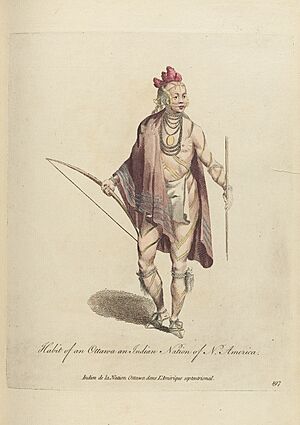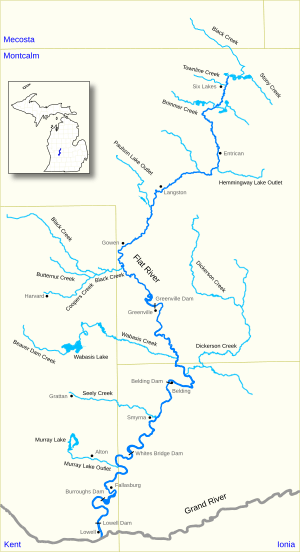Cobmoosa facts for kids

Cobmoosa (1768 - 1866), also known as Weebmossa meaning "Great Walker," was an important Odawa leader. He lived in a Native American village near the Flat River in what is now Lowell, Michigan. He lived there until 1858.
In the 1830s, many white settlers wanted to move to Michigan. This land was the traditional home of several Native American tribes. The United States government began talking with tribal leaders in 1836. They wanted the tribes to move their homes.
Cobmoosa was one of 54 Odawa and Chippewa leaders. He helped with the 1855 Treaty of Detroit. This treaty allowed the Odawa and Chippewa people to stay in Michigan. Before this, the government had tried to make them move to Kansas. After the 1855 treaty, Cobmoosa's tribe moved to Elbridge Township in Oceana County, Michigan. The tribes received money and goods. However, much of it went to non-Native people involved in the talks.
Cobmoosa lived to be 98 years old. He spent his last years in a log cabin built by the government. This cabin was near Cobmoosa Lake. He was known for his wise words and dignified way of walking. A poem called Cobmoosa's Lament was written for him. The town of Cobmoosa was named after him. A stone monument was also built in his honor in Hart, Michigan.
Contents
Cobmoosa's Early Life and Family
Cobmoosa was born in 1768. His birthplace was a village near the Rapids of the Grand River. People believe his father was Antoine Campau, a Frenchman from Montreal. His mother was said to be the daughter of an Odawa chief. Cobmoosa once said his father supported the Americans during the Revolution. He grew up to be a tall man with long steps.
Cobmoosa had several wives. Three of them were the daughters of another leader, Wabiwindego. He had three daughters: Ne-gance, Mrs. Cub-as-ka, and Mrs. Ne-gak. His sons were named Henry, Antoine, and James.
A Respected Leader and Merchant
Cobmoosa was highly respected by the Native people in the Grand River Valley. He was known for his powerful speeches and impressive presence. His Odawa village was located near the mouth of the Flat River. This area is now the town of Lowell, Michigan.
By 1833, Cobmoosa was the second-in-command of the Flat River Native American groups. That year, the village of Ionia was started by 63 people from New York. These newcomers needed a place to live. Cobmoosa's village moved about three miles away. The new settlers then bought the tribe's wigwams and took over the old village site.
Cobmoosa also ran a trading post at the Flat River's mouth. Over time, he became known as a man of "great dignity" and "strong character." Later, he moved into a house in Lowell with his wife, Sophia. He even ran a grocery store on Main Street.
The Important Treaty of 1855
More white settlers kept moving into the area. This created pressure for a new treaty about Native American land. Cobmoosa was one of 24 Odawa and Chippewa leaders who went to Washington, D.C. They met with the president to discuss a treaty. The government wanted the tribes to give up all their land north of the Grand River.
The 1836 treaty had not worked out. The tribes learned they had to move to Kansas. This was a problem because of the long distance and different environment. So, the treaty was renegotiated. The new plan was for the Odawa and Chippewa tribes to move to Oceana and Mason Counties in Michigan.
In 1855, Cobmoosa signed the Treaty of Detroit with the government. This meant his tribe would move to Oceana County, Michigan. Fifty-four other Odawa and Chippewa leaders also signed this treaty in Detroit. In return for their ancestral lands, the tribes received about $540,000 in money and goods. This was to be paid over 10 years. Much of this money went to non-Native "friends," like Cobmoosa's uncle Louis Campau. The chiefs received $500, and headmen received $100.
Cobmoosa's people moved to Elbridge Township. The government built a log cabin for him in Cobmoosa, Michigan. By 1858, he and 1300 others had moved. Cobmoosa was slow to move to the new reservation. He waited until all his tribe had relocated. He stayed near the graves of his ancestors as long as he could. However, he did visit Oceana County to be with his tribe members.
Later Years and Legacy
Cobmoosa's cabin was on 80 acres given to him in Oceana County. It was along Cobmoosa Lake. He lived there with one of his daughters and her husband, Joe Bailey. He also spent time with another daughter, Wassia, and her husband, Jerome Ne-gake. They had a farm across the lake from his cabin.
Cobmoosa died in 1866 at 98 years old. He was buried in Elbridge Township, Michigan, near his cabin. A monument was built for Cobmoosa where the first government schoolhouse stood. The Daughters of the American Revolution's Ionia chapter created the monument. It says: "Ottawa Indian Chief and Great Speaker of the Tribe. Born at the Rapids of the Grand River, 1768. Died on this reservation, 1866."
The poem Cobmoosa's Lament was written in his memory. Alden Jewell of Grand Rapids wrote it. It was published in the Grand Rapids Eagle in 1854. The "Cobmoosa Stone" is a monument in his honor in Hart, Michigan. The Daughters of the American Revolution dedicated it in 1927. He was honored for his role in the 1855 Treaty of Detroit. This treaty led the Odawa people to move to Mason and Oceana counties in Michigan.
Another monument was put up at the Ionia Fairgrounds in 1922. This plaque says that Cobmoosa's group lived in a seasonal village near what is now Ionia.


